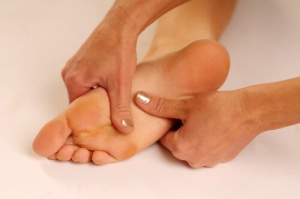Pain Treatment for the Soles of the Feet


Written and verified by the pedagogue in physical education and nutritionist Elisa Morales Lupayante
Pain in the soles of the feet, or the plantar fasciitis, affects the lower part of the heel, in precise terms. Nevertheless, it could spread throughout the entire foot and, in some cases, even affect another area entirely. This pain could be caused by excessive pressure on the feet, causing the ligaments to rupture and creating pain and stiffness in the heel.
Causes of plantar fasciitis
Plantar fasciitis is caused primarily by:
- Excessive weight
- Pregnancy
- Work days that are too heavy
- Poor footwear usage
- Having flat feet or very high arches
See Also: Why Dance Therapy is so Good For You
Symptoms of plantar fasciitis
The symptoms caused by this condition are generally:
- Pain
- Burning below the heel (or in the entire foot)
- Stiffness
This problem generally only occurs in only one foot, but it can affect both feet as well.
This condition is a lot stronger in the morning when you take your first steps after a long night’s rest or after you’ve been sitting or resting for a long time. You could also feel it after a particularly long exercise session. In short, any activity that keeps you on your feet for a long time can trigger it.
Pain treatment for the soles of the feet
The suggested treatment for pain in the soles of the feet is fundamentally to reduce the inflammation.
Home remedies

The first thing you need to do is go barefoot for as long as possible. Apply ice to the affected area at least four times a day, for 20 minutes each time. This helps reduce inflammation in the affected area.
Put an orthotic in your shoes that supports the arch of your foot so as to reduce the pain.
Set aside at least 20 minutes a day to practicing stretching exercises.
Take a few anti-inflammatory medications, such as ibuprofen. This might help you out with the pain, but don’t go overboard.
Medical treatments
If the anti-inflammation drugs don’t provide the effect you’re looking for, try a much stronger and more effective treatment, like a corticosteroid injection. These are injected directly into the affected ligament, the heel, or the arch of the foot. Afterwards, the therapist applies a painless electrical current, so that the steroid will penetrate the skin and the muscle.
Also Read: 6 Solutions for Smelly Feet
Your professional might also choose physical therapy, in which you will stretch the plantar fascia and the Achilles tendons. Likewise, they will also recommend exercises to strengthen the lower leg muscles.
In some cases, you will absolutely need to use night splints. These can help stretch the calf and the arch of the foot. This will keep the foot flexed, stretching out the plantar fascia and the Achilles tendon, thereby reducing pain and stiffness in the morning.
You could also use orthopedics in your shoes that help distribute pressure more evenly. This may prevent even greater damage to the plantar fascia.
Remember…
It is extremely important that you keep an eye on every symptom that you have. If you don’t feel any improvement after starting treatment with home remedies, it’s best to see a trusted doctor immediately and follow the treatment plan that he or she recommends.
All cited sources were thoroughly reviewed by our team to ensure their quality, reliability, currency, and validity. The bibliography of this article was considered reliable and of academic or scientific accuracy.
- Na HS, Ryu JH, Do SH. El papel del magnesio en el dolor. En: Vink R, Nechifor M, editores. Magnesio en el Sistema Nervioso Central [Internet]. Adelaide (AU): University of Adelaide Press; 2011. Disponible en: https://www.ncbi.nlm.nih.gov/books/NBK507245/
- Goff, J. D., & Crawford, R. (2011). Diagnosis and treatment of plantar fasciitis. American Family Physician, 84(6), 676–682.
- McPoil, T. G., Martin, R. L., Cornwall, M. W., Wukich, D. K., Irrgang, J. J., & Godges, J. J. (2008). Heel Pain—Plantar Fasciitis. Journal of Orthopaedic & Sports Physical Therapy, 38(4), A1–A18. https://doi.org/10.2519/jospt.2008.0302
This text is provided for informational purposes only and does not replace consultation with a professional. If in doubt, consult your specialist.








